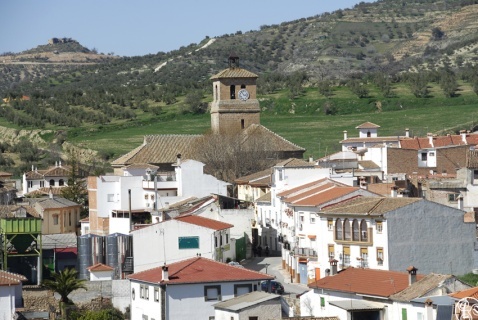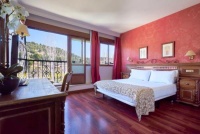
The village of Alfacar |
|
Alfacar
Alfacar is one of the entry points into to the Sierra de Huétor Natural Park. The area surrounding the village is wonderful for trekking and there are many paths to follow. Alfacar is also known as the place where Spain’s famous poet Federíco Garcia Lorca was shot during the Spanish Civil War. The village has therefore dedicated a park to his memory and that of others executed during the war. Alfacar has a population of around 5,200.
HISTORY
The first records of Alfacar as a settlement date from the Zirid period (1010-1090). The name Alfacar comes from the Arabic term al-Fajjar, which means mud, clay or pottery. At that time, palaces, mosques, towers and a castle were built in the area of Aynadamar (today's Fuente Grande). Some buildings have survived, such as the Arco de Somera, the baths, the Acequia de Aynadamar and part of the old wall.More>

THINGS TO SEE
Iglesia de la Asunción
The church dates from the mid-16th century and was built after an older church was demolished in 1557. The old church was built on the site of an Arab mosque, which was consecrated after the Catholic Monarchs ordered the purification of these temples. It was originally dedicated to the intercession of Santa María de los Ángeles.
The material used for its construction is travertine stone from local quarries. These stones were also used in the construction of the Cathedral of Granada. The use of these stones was not common in Mudejar churches in the province of Granada. The stonemason who worked on the church was Sancho De Venero. The church has a single rectangular nave with a large triumphal arch that delimits the presbytery. The bell tower is rectangular. It has a Mudejar coffered ceiling. The interior contains a wide variety of works of art, including a 16th-century Cristo en la Cruz, four 17th-century paintings from the Granada School in the main chapel, the high altarpiece, the altarpiece of the Eucharist with the image of the Immaculate Conception and an 18th-century sculpture of San Antonio. Located in Plaza Prado.
Arco de Somera
It is believed that the village of Alfacar had two walled enclosures, of which very little remains today. The inner wall, or fortress, would have occupied the area between the current entrance to the village, Plaza de la Iglesia, and Cárcel and Zancanal streets. The outer enclosure, or walled city, would have included what is now the old town. This extends from the present south-western end and the Plaza de la Iglesia to the north-eastern area of the Arab baths. A wall extends from the old fortress to the Plaza de la Iglesia. The complex has been declared a Site of Cultural Interest. Located on Calle Cuba.
Baños Arabes
The discovery of the Arab baths is recent, as the remains were hidden under several houses. The remains of Arab baths have been discovered hidden under several houses in the village. They follow the style of the thirteenth to fifteenth century Zirid period, with parallel naves. Only the warm room and the hot room have survived. The dressing room and the cold room have disappeared. The walls of the bathhouse were built with Alfacar stone blocks and brick vaults. Both rooms measure around five metres long and three metres wide. A segmental arch leads to the hot room. In the hot room, in front of the door, there are the remains of an immersion bath and, to one side, the remains of a chimney. The water for these baths came from the Aynadamar irrigation canal, which supplied the city. The baths are currently being restored. Located in the Plaza del Baño.
Fuente de las Lágrimas
Fuente Grande is also known as Fuente de las Lágrimas (Spring of Tears). This is due to the small air bubbles that rise from the pond. The spring dates back to the eleventh century. The Moors called it Aynadamar, Ayn (eye and, therefore, well, because it is the source of tears). The Fuente Grande is the most important of Alfacar's Muslim monuments and springs that have survived to the present day.
The water from the Fuente Grande was channelled through the Aynadamar irrigation canals and aqueducts to the city of Granada, supplying water to the Alhambraand the Albaicín. This is one of the reasons why Alfacar was heavily defended and became one of the last Moorish strongholds to fall to the Catholic Monarchs at the end of the Reconquest. The neighbouring town of Viznar was founded as a result of the canalisation of the waters of the Fuente Grande. The beauty of the Fuente Grande and its surroundings has been praised by poets and historians from ancient times to the present day. It is located near the Federico García Lorca Park.
THINGS TO SEE OUTSIDE THE TOWN
Sanatorio de Alfaguara
In the Sierra de Alfaguara, north-east of Alfacar, there is an old tuberculosis hospital. A German woman, Berta Wilhelmi, altruistically built the hospital to treat the disease that had killed her brother. Berta Wilhelmi was a great philanthropist throughout her life. A woman ahead of her time, she was concerned about social problems. After her death and after the civil war the Sanatorio was abandoned. It has been rehabilitated by the Alfacar Town Hall.More>
Ermita de San Sebastián
The chapel was built in 1899 and is dedicated to the town's patron saint. It is located in the centre of the town's cemetery. At the feet of the patron saint is the tomb of Don Eduardo Yañez Marín, who was the parish priest until 1974. In 1994 this chapel was restored by the Alfacar Town Hall. The local artist Francisco Javier Marín Marín painted a mural on the altar of the hermitage. Located on the GR-3103.
Acequia de Aynadamar
This long aqueduct, known as the Acequia de Aynadamar, was built at the end of the 11th century and is one of the greatest historical engineering works in Andalusia. Its source is the Fuente Grande spring. It was used for drinking water and irrigation. Along its route we find several small bridges. Their stone construction prevents rainwater from damaging the canal, as it would in a simple irrigation ditch. The construction also prevents the water from becoming cloudy and ensures that it is drinkable. It has been declared an site of Cultural Interest.
Puente del Caracolar
Puente del Caracolar is built on a stone foundation and has a brick arch.
Puente de Corvera
The Corvera Bridge is identical in design to the Puente del Caracolar, its function being as a footpath and covered aqueduct to the nearby farmhouse.
Puente de los Arrieros
After the municipal boundary between Alfacar and Víznar, there is a path and the Arrieros bridge. Its dimensions and style of construction suggest that it was connected to a network of mule tracks that linked the town to each other and to other routes in the Kingdom of Granada.
Trincheras de la Alfaguara
In Alfaguara there are still defensive structures from the Spanish Civil War. These are structures that have been forgotten since the war in the 1930s. Tunnels, trenches, staircases and shelters that formed the trenches as defensive and offensive elements. They were also used to monitor and control the mountain passes and paths. They have been preserved as silent witnesses to the lives and deaths of hundreds of people in a sad period of Spanish history. The remains of these structures, most of which are well preserved, form an extensive network of military positions that are now of historical interest. Many of them have been preserved almost as they were when they were built, thanks to their hidden and inaccessible location.
The Sierra de Huétor Nature Reserve has a large network of ditches that can be visited, such as Cuartel de José Antonio, Trincheras de Cerro Calvero, Trincheras de los Corralillos, Trincheras de Alonso, Avanzadilla de Nívar, Trincheras Cerro de la Encina and Llanos del Fraile.
The Asociación Alfanevada, dedicated to promoting and carrying out projects in the Arco Noreste de la Vega de Granada, has documented several routes through the ditches.
Natural Areas
Parque Federico García Lorca
The Federico García Lorca Park in Alfacar is located in a place surrounded by pine trees and the Alfaguara mountain range. It is believed that the poet Federico García Lorca was shot here at the beginning of the Spanish Civil War on 18 August 1936.
The park was inaugurated in 1986 and has paths, fountains and a wall with verses from Lorca's poems. A monumental stone has been placed next to the olive tree where the poet is said to have died. Every year on the evening of 18 August, the park is the setting for a concert and recital of Lorca's work. For more information about the park, see History of Alfacar.
Arboretum de la Alfaguara
The old Alfaguara forest nursery has been converted into an arboretum and botanical trail, concentrating much of the rich biodiversity of the Huétor mountain range. Composed of evergreen conifers and broad-leaved trees, the stars of the arboretum are the Spanish firs and the cedars, which are several hundred years old, the latter impressing the visitor with their enormous size, more than 35 metres high and almost three metres in diameter. The presence of deciduous trees such as cherry, hawthorn, elm, maple and poplar, among many others, makes this route particularly attractive in autumn, when the leaves of these trees take on spectacular colours. As if that were not enough, the Alfaguara Arboretum is a refuge for birds such as the blackbird, the greenfinch, the crossbill and the goldcrest, which find an ideal place to live.
Sierra de Huetor Natural Park
Designated a Nature Reserve in 1989, the 12,128ha Sierra de Huétor is located just a few kilometres north-east of the provincial capital of Granada, making it a popular weekend destination for city dwellers. The mountainous area has dramatic geological features characteristic of limestone areas, with narrow gorges, sheer cliffs, springs and caves such as Cueva del Agua. The most famous spring is the Fuente Grande de Alfácar, which was cleverly used by the Moors as a source of water for the Albaicín in the city of Granada, and transported through an irrigation canal called the Aynadamar.More>
Bus Service
There is a bus service from Alfacar to Granada City.More>
Gastronomy
Bread is a universal food, but Alfacar's long baking tradition has made its bread a unique product. It is a local and traditional bread, with a recipe handed down through generations of bakers who have made it famous. Alfacar has the quality resources needed to make this bread: water from its springs, firewood from the Alfaguara forests for baking in the Moorish ovens, thyme and rosemary to give the bread its aroma, and the old mills that supplied the flour to the bakers.
Since 14th July 2011, Pan de Alfacar has been registered by the Andalusian Government as a Protected Geographical Indication, similar to the DO often associated with wine. This registration protects the buns, roscos, roscas and breads of Alfacar, which continue to be made in the traditional way.
Visit any one of these bakers to try the Pan de Alfacar:
Panadería Enrique Fernández
Pan de Mariano
Panadería Geni
Panadería-Pastelería San Juan
Panadería Eduardo Vílchez
Panadería y bollería Horno de Gabriel
Festivals
Popular festivals in Alfacar are Noches de los Capachos, Fiestas Patronales de San Sebastián, Carnavales, Fiestas de San Pedro, Cruces de Mayo and Semana Santa. More>
Weather Forecast
The weather forecast for the next few days for Alfacar. More>
Tourist Office
The tourist office of Alfacar is located on Calle del Baño.More>
Nearby Places
The neighbouring villages to Alfacar are Víznar and Albolote.


